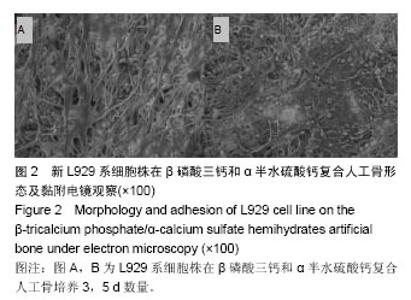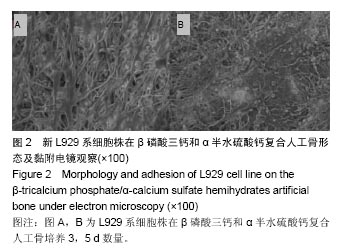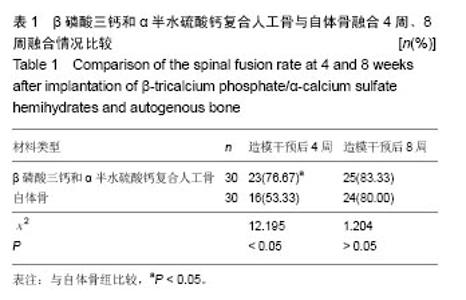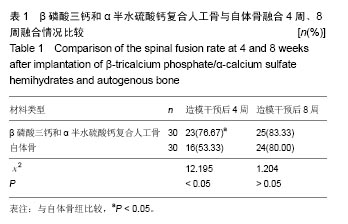| [1]吴海啸,张超,Goryaeva GL,等.β-TCP/α-CSH复合材料骨支架在骨缺损治疗中的应用研究进展[J].山东医药, 2016,56(32): 104-106.[2]兰家平,张智.β磷酸三钙/α半水硫酸钙复合人工骨材料研究进展[J].中国伤残医学,2016,24(14):94-96.[3]杨柳,赵龙涛,王方然,等.P(3HB-co-4HB)/α-CSH复合材料的结晶性能和流变性能研究[J].塑料科技,2016,44(4):71-75.[4]杨晓勇,徐永清,唐辉,等.新型α半水硫酸钙/β磷酸三钙复合人工骨材料理化特性研究[J].第三军医大学学报, 2016,38(2): 161-166.[5]Mao K, Zhou F, Cui F, et al. Preparation and properties of α-calcium sulphate hemihydrate and β-tricalcium phosphate bone substitute. Biomed Mater Eng. 2013;23(3):197-210.[6]韦标方.病灶清除自体骨联合自骨化磷酸钙人工骨植入治疗早期非创伤性股骨头坏死[J].第三军医大学学报, 2014,36(8): 773-779.[7]杜建,丁元法,苏向东,等.医用镍钛形状记忆合金的表面改性及生物相容性[J].中国组织工程研究,2012,16(25):4689-4691.[8]Ball JP, Mound BA, Nino JC, et al. Biocompatible evaluation of barium titanate foamed ceramic structures for orthopedic applications. J Biomed Mater Res A. 2014;102(7):2089-2095[9]李鹏程,刘玉玲,党群,等.雌激素受体α、雌激素受体β、激活蛋白1、血管内皮生长因子在大鼠子宫内膜异位症模型中的表达及意义[J].中国现代医学杂志,2016,26(14):7-11.[10]覃建朴,王翀,张朋云,等.不同植骨融合材料在腰椎椎体间脊柱融合中的应用[J].中国组织工程研究,2016,20(25):3693-3698.[11]惠宇,武君胜,鱼滨,等.利用曲率多特征融合改进人体三维脊椎模型特征点的标注方法[J].光学精密工程, 2016,24(11): 2872-2879.[12]杨保家,杨开舜,姚汝斌.影像及生物力学测试尼古丁剂量与腰椎后外侧植骨融合率的相关性[J].中国组织工程研究, 2016, 20(48):7251-7260.[13]刘英杰,彭俊,刘小康,等.椎间融合引起相邻节段退变的动物实验模型[J].中国组织工程研究,2016,20(39):5825-5833.[14]吴立军,余凤娇,何登伟,等.脊柱后方3D融合预防胸腰椎骨折晚期矫正丢失:有限元分析与随机对照试验[J].中国生物医学工程学报,2016,35(2):184-193.[15]He DW, Wu LJ, Sheng XY, et al. Internal fixation with percutaneous kyphoplasty compared with simple percutaneous kyphoplasty for thoracolumbar burst fractures in elderly patients: a prospective randomized controlled trial. Eur Spine J. 2013;22:2256-2263.[16]卓祥龙,吕红斌,胡建中,等.纳米羟基磷灰石/涂层双相磷酸钙人工骨移植脊柱后外侧融合:组合磁场的辅助作用[J].中国组织工程研究,2016,20(34):5089-5097.[17]彭祥,王文军,晏怡果,等.解剖型纳米羟基磷灰石/聚酰胺66椎间融合器在腰椎XLIF/OLIF手术中的三维有限元分析[J].中国临床解剖学杂志,2016,34(5):557-562.[18]袁峰,陆海涛,邓斌,等.3D打印模型在颈椎后纵韧带骨化手术减压方式选择中的应用[J].中国组织工程研究, 2016,20(39): 5852-5858.[19]Yang JC, Ma XY, Xia H, et al. Clinical application of computer-aided design-rapid prototyping in C1-C2 operation techniques for complex atlantoaxial instability. J Spinal Disord Tech. 2014;27(4):E143- E150.[20]张元智,裴国献,陆声,等.计算机辅助确定下肢机械轴线在全膝关节置换术中的应用[J].中华骨科杂志,2013,33(12):1196-1203.[21]甘煜东,徐达传,陆声,等.数字化导航模板辅助全膝关节置换的模拟研究[J].中华骨科杂志,2011,31(9):964-969.[22]邱冰,张明娇,唐本森,等.个性化手术导板在全膝关节置换术中的应用[J].中华骨科杂志,2016,36(3):143-150.[23]Lee CK, Shin DA, Yi S, et al. Correlation between cervical spine sagittal alignment and clinical outcome after cervical laminoplasty for ossification of the posterior longitudinal ligament. J Neurosurg Spine. 2016;24(1):100-107.[24]左睿,孙永建,吴毅,等.3D打印与虚拟手术设计在复杂胫骨平台骨折手术治疗中的应用[J].中国骨与关节损伤杂志, 2016, 31(4):369-372.[25]李涛,陈卓夫,龚辉,等.3D打印技术在复杂髋臼骨折术中的初步临床应用[J].中国骨与关节损伤杂志,2016,31(4):387-388.[26]庞骄阳,赵岩,肖宇龙,等.3D打印技术在脊柱外科的应用[J].中国组织工程研究,2016,20(4):577-582.[27]Ferrari V, Parchi P, Condino S, et al. An optimal design for patient-specific templates for pedicle spine screws placement. Int J Med Robot. 2013;9(3):298-304.[28]Kaneyama S, Sugawara T, Sumi M, et al. A novel screw guiding method with a screw guide template system for posterior C•-2 fixation:clinical article. J Neurosurg Spine. 2014;21(2):231-238.[29]Merc M,Drstvensek I,Vogrin M,et al.Error rate of multi-level rapid prototyping trajeetories for pedicle screw placement in lumbar and sacral spine. Chin J Traumatol. 2014;17(5): 261-266.[30]Hu Y, Yuan ZS, Kepler CK, et al. Deviation analysis of C1-C2 transarticular screw placement assisted by a novel rapid prototyping drill template: a cadaveric study. J Spinal Disord Tech. 2014;27(5):E181-E186. |





